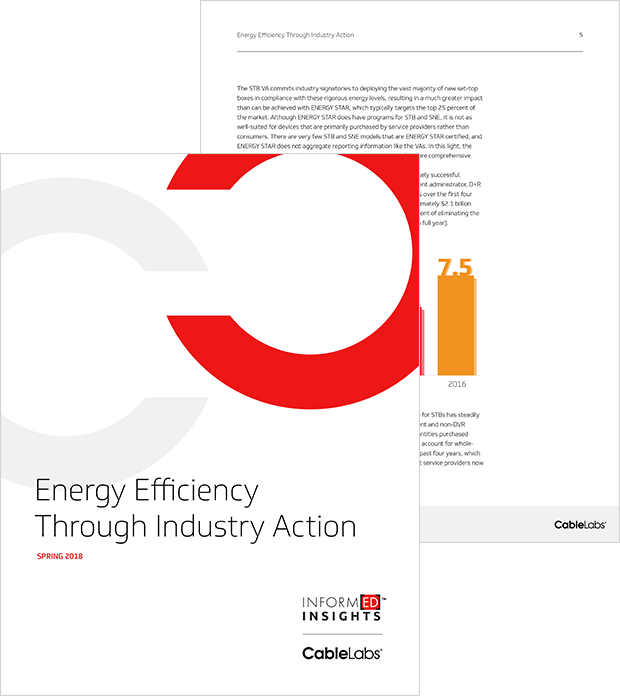SPRING 2018
Energy Efficiency Through Industry Action
Over the last five years, the North American communications industry has provided customers increased bandwidth, new and innovative ways to consume content and exciting new services. Behind the scenes, we have also reduced the energy required to deliver these new innovations. In so doing, the communications industry has enabled consumer and environmental benefits in a rapid and flexible manner, serving as a model for how private efforts can drive sustainability.
Executive Summary
The cable industry is at the forefront of technological innovation, enabling connectivity and entertainment for millions of consumers around the globe. As a platform with broad reach, cable is positioned to deliver significant value for its customers. As the industry delivers compelling content and connects consumers through broadband Internet access, it is also working to reduce the energy consumption of the network. These practices save customers money on energy bills and contribute to environmental sustainability.
One important mechanism for driving sustainability is concerted industry action to reduce the energy usage of its widely-deployed devices: For cable, this means set-top boxes (STBs) and other small network equipment (SNE). This has taken the form of highly successful voluntary agreements (VAs) in the United States and Canada, which include firm efficiency commitments, enforcement of those commitments, and regular reporting. The independent administrator of these VAs, D+R International, notes the US Set-Top Box Voluntary Agreement (STB VA) has saved over 16.8 TWh and over $2.1 billion in energy costs over the first four years of the program. The US Small Network Equipment VA (SNE VA) has reduced the device energy consumption relative to broadband and WiFi speeds by an average of 20 percent year over year. Following the success of these US-based initiatives, an analogous VA was established in Canada last year. The Canadian Energy Efficiency Voluntary Agreement for Set-Top Boxes (CEEVA) will report energy savings outcomes later this year.
These voluntary agreements impact sustainability in a manner that would not be possible under other approaches, including direct government intervention. Industry action in this area has proven to deliver rapid results, evolve quickly to drive further efficiency gains enabled by technological advances, and provide the freedom for ongoing product innovation that benefits consumers’ communications experiences. For these reasons, the VA model is a case study for how private entities can work toward the public good.
Introduction
Cable connects consumers around the globe, and a connected society enables efficient commerce. The industry’s efforts to reduce the energy usage of its networks and devices are not only good for business, they also extend the environmental benefits inherent in network connectivity. For instance, consider telecommuting: A 2017 study found that the 3.9 million US telecommuters reduce greenhouse gas emissions substantially, an amount equivalent to taking more than 600,000 cars off the road for a year.[1] As the providers of ever-advancing connectivity, the cable industry facilitates sustainable productivity.
In recent years, the industry has undertaken additional measures to make their services even more environmentally friendly. The Society of Cable Telecommunications Engineers (SCTE) established the Energy 2020 program[2] to address energy efficiency in the cable head-end, delivery network, facilities and operations. And three energy efficiency voluntary agreements have been formed in North America to address set-top boxes (STBs) and small network equipment (SNE) that consumers use in the home. In late 2012, the major U.S. Pay TV providers joined manufacturers and trade associations to establish the award-winning[3] Voluntary Agreement for Ongoing Improvement to the Energy Efficiency of Set-Top Boxes[4] (STB VA), and has accumulated impressive energy savings since the program went into effect. In 2015, the major U.S. broadband providers, equipment manufacturers and trade associations established a similar voluntary agreement for Small Network Equipment (SNE VA), and in 2017 Canada established the Canadian Energy Efficiency Voluntary Agreement (CEEVA) for STBs[5].
In 2016, the STB VA was recognized by Environmental Leader as a Top Project of the Year.
These energy efficiency voluntary agreements align the interests of consumers, energy efficiency advocates, regulators, and service providers, allowing common goals to be achieved. The benefits of the energy efficiency voluntary agreements include:
- Improving the energy efficiency of devices in consumer homes, thereby reducing demands on production and greenhouse gas emissions;
- Promoting product innovation;
- Saving consumers money on their electricity bills; and
- Increasing product reliability, resulting in fewer service visits, longer product lifetimes and reduced recycling of devices.
- This paper takes a closer look at these voluntary agreements and explores how the structure of the agreements enables these benefits.
Set-Top Box Voluntary Agreement
Consumers receive television content via a set-top box that manages content, security, and navigation – one of the many electronic devices that populate the modern home. The Set-Top Box Voluntary Agreement (STB VA) was originally developed in 2012 as a result of discussions among the television content distributors, technology suppliers, energy advocates, and the U.S. Department of Energy. Recognizing the potential benefits of a concerted effort to improve the energy efficiency of set-top boxes, the group forged an agreement with specific, measurable targets. This initial agreement has been updated over time to account for new innovations in energy usage and new services.
The signatories of the expanded STB VA include Pay TV service providers across cable, satellite, and telco, as well as manufacturers and energy efficiency advocacy organizations.
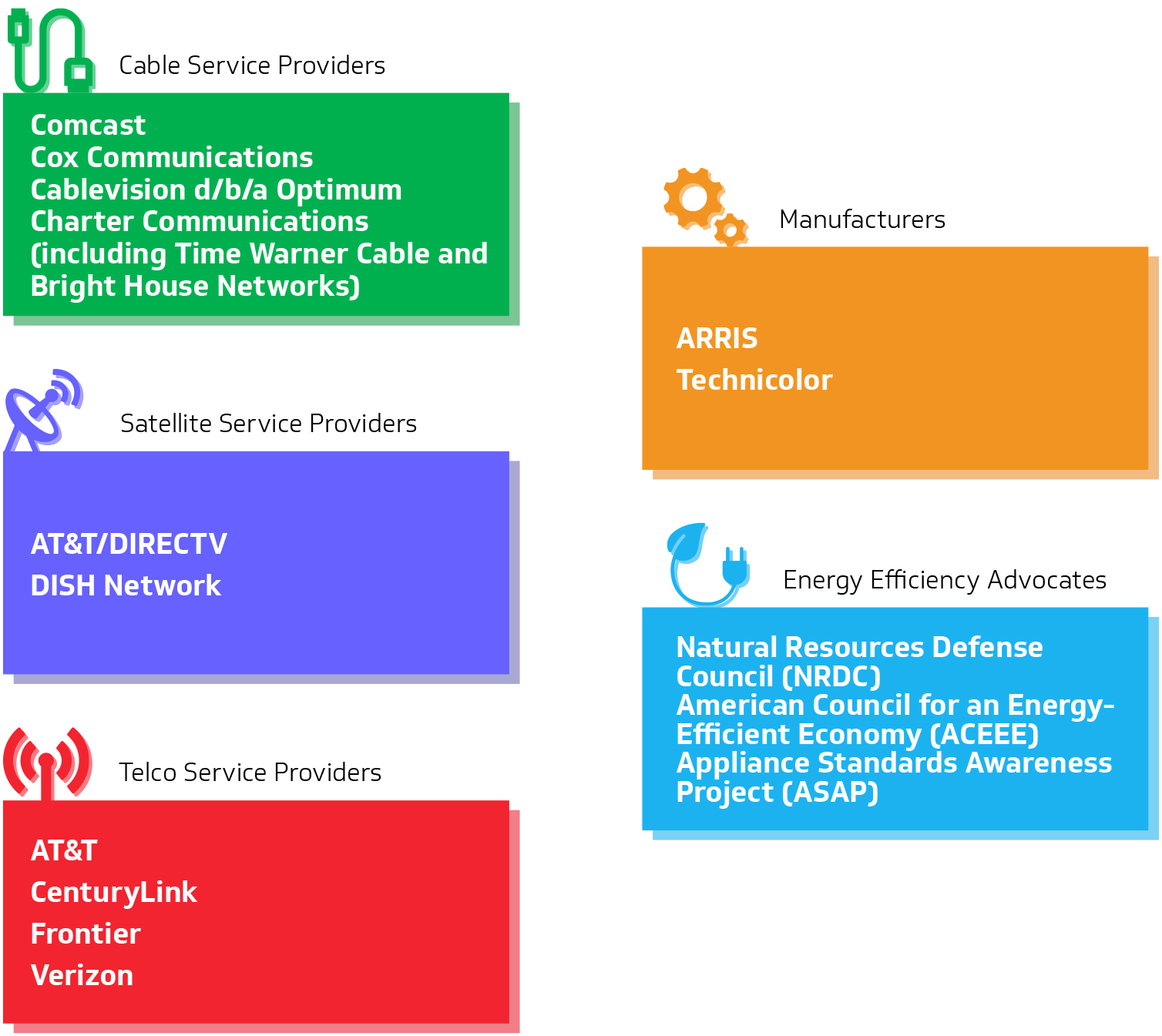
These companies represent all major video service provider platforms, serving more than 90 million households in the United States, and representing over 90 percent of the paid television service industry.
The service provider commitments for the STB VA are robust, with broad adoption of increasingly efficient products, as well as compliance assurance procedures and reporting. Specifically, the key commitments of the STB VA are as follows:
- From 2014 through 2016, at least 90 percent of all new STBs purchased had to meet Tier 1 levels.
- Beginning in 2017, at least 90 percent of all new STBs purchased must meet the more aggressive Tier 2 levels.
- To support transparency and accountability, the STB VA utilizes an independent administrator to verify service provider reports, determine compliance, conduct audits, and prepare annual reports.[6]
- For additional transparency, service providers are required to make the energy consumption information of their STBs publicly available.[7]
- In an annual verification process, an independent tester verifies energy consumption of STBs.
- Most newly-purchased STBs have a light sleep capability that lower the power consumption in standby mode. The cable service providers also deployed light sleep on existing deployed STBs that were capable of supporting light sleep.
- Operators accelerated the deployment of whole-home Digital Video Recorders (DVRs) and client STBs, thus reducing the number of DVR devices within the home.
The agreement initially established a Tier 1 set of energy efficiency levels that were based on ENERGY STAR’s STB program (specifically Version 3.0). In 2013, the agreement was expanded to include energy efficiency advocates as signatories, as well as to define an even more rigorous set of energy efficiency levels, known as Tier 2, which went into effect in 2017.[8] At the same time, the Department of Energy (DOE) was pursuing a regulatory approach to achieving advances in STB energy efficiency. Upon the announcement of the expanded VA, the DOE recognized the greater potential of industry-led action to improve upon these goals and refrained from regulating.[9] And in fact, this approach has delivered energy savings well beyond what could have been achieved through a more static and prescriptive regulatory approach.
“This is a big win for nearly every American who pays a monthly television bill because experts tell me that federal standards could not have produced this much financial and energy savings by 2017.” --Senator Diane Feinstein D-California[10]
The STB VA commits industry signatories to deploying the vast majority of new set-top boxes in compliance with these rigorous energy levels, resulting in a much greater impact than can be achieved with ENERGY STAR, which typically targets the top 25 percent of the market. Although ENERGY STAR does have programs for STB and SNE, it is not as well-suited for devices that are primarily purchased by service providers rather than consumers. There are very few STB and SNE models that are ENERGY STAR certified, and ENERGY STAR does not aggregate reporting information like the VAs. In this light, the voluntary agreements driven by industry have proven to be far more comprehensive.
The implementation of the STB VA commitments has been immensely successful. According to the most recent report from the program’s independent administrator, D+R International, the STB VA has amassed 16.8 TWh in energy savings over the first four years.[11] This savings has reduced consumer energy bills by approximately $2.1 billion and avoided 11.8 million metric tons of CO2 emissions (the equivalent of eliminating the carbon emissions caused by nearly 2.5 million passenger cars for a full year).
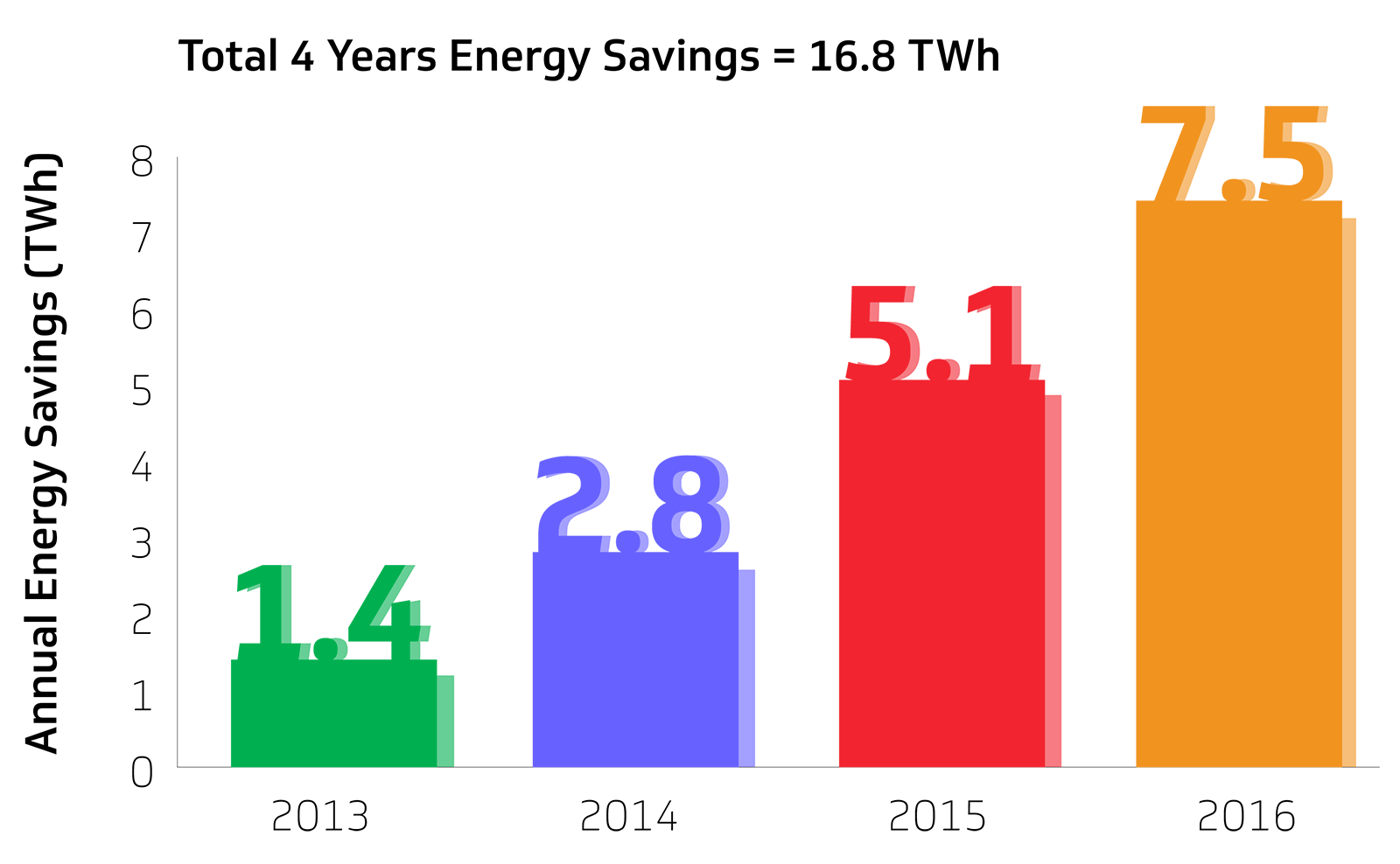 Figure 1: STB VA Annual Energy Savings
Figure 1: STB VA Annual Energy SavingsD+R also reported that the weighted average energy consumption for STBs has steadily declined – DVR energy consumption has been reduced by 40 percent and non-DVR consumption by 28 percent. These values are weighted by the quantities purchased of each model in the reporting period (calendar year). This doesn’t account for whole-home DVR configurations that have also been rolling out over the past four years, which provides further energy savings relative to multi-DVR homes. Most service providers now offer consumers the ability to have a single DVR in their house with the ability to record multiple programs simultaneously and play them on lower-power non-DVR STBs or even smart TVs, PCs and mobile devices.
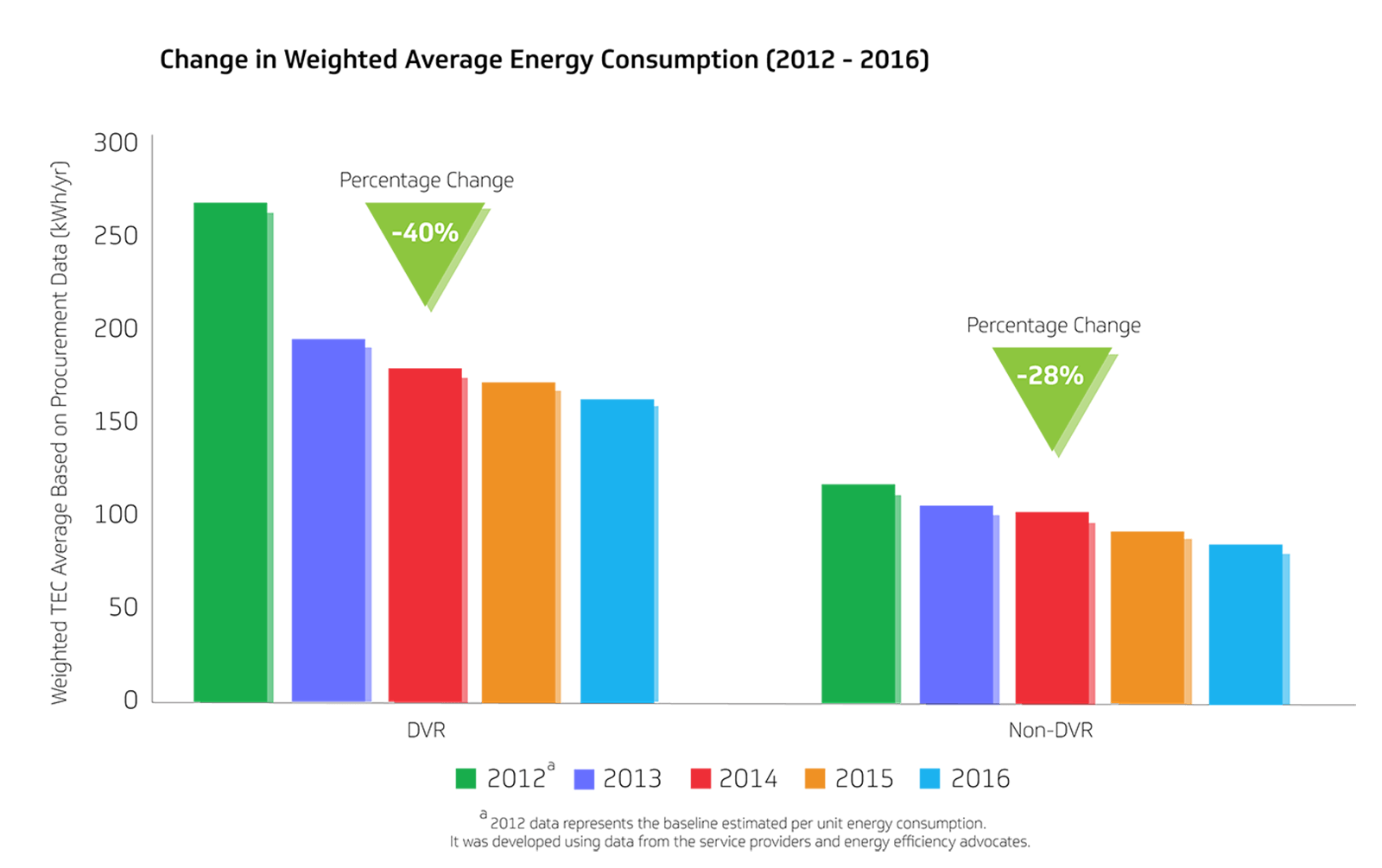 Figure 2: STB VA Weighted Average Energy Consumption Trends
Figure 2: STB VA Weighted Average Energy Consumption TrendsSmall Network Equipment Voluntary Agreement
In addition to Set-Top Boxes, service providers deploy modems, routers, and other types of devices known as Small Network Equipment (SNE) in customers’ homes to enable their residential broadband services. In 2015, to build upon the success of the STB VA, the residential broadband industry established the Voluntary Agreement for Ongoing Improvement to the Energy Efficiency of Small Network Equipment (SNE VA). The SNE VA signatories to date are:
- AT&T
- Cablevision d/b/a Optimum
- CenturyLink
- Charter (Spectrum)
- Comcast
- Cox
- Frontier Communications
- Verizon
- Actiontec
- Arris
- D-Link
- Echostar Technologies
- NETGEAR
- Technicolor
- Ubee Interactive
The SNE VA is modeled after the STB VA and has a similarly robust set of commitments to energy efficiency, compliance, and reporting:
- Beginning in 2016, at least 90 percent of all new SNE devices purchased by service providers or sold through retail by vendor signatories must meet levels established in the SNE VA.
- The SNE VA also utilizes an independent administrator to verify service provider and vendor reports, determine compliance, conduct audits, and prepare an annual report.
- Service providers and vendors are required to make the energy consumption information of their SNE models within the scope of the VA publicly available.
- The independent administrator selects one model at random from each signatory to be tested in a third-party lab or under the supervision of an accredited third party to verify reported values.
- Small Network Equipment has been evolving at a rapid pace, increasing network speeds from the service provider to the home, and also increasing networking capability within the home. Many of the newer SNE products integrate multiple functionalities that had been supported with separate devices, including broadband modem functionality, high-speed WiFi, multi-port routing, and Internet of Things (IoT) controllers. Although broadband performance has grown rapidly, the energy consumption of SNE devices has actually decreased relative to broadband speeds. This is depicted in the chart below.
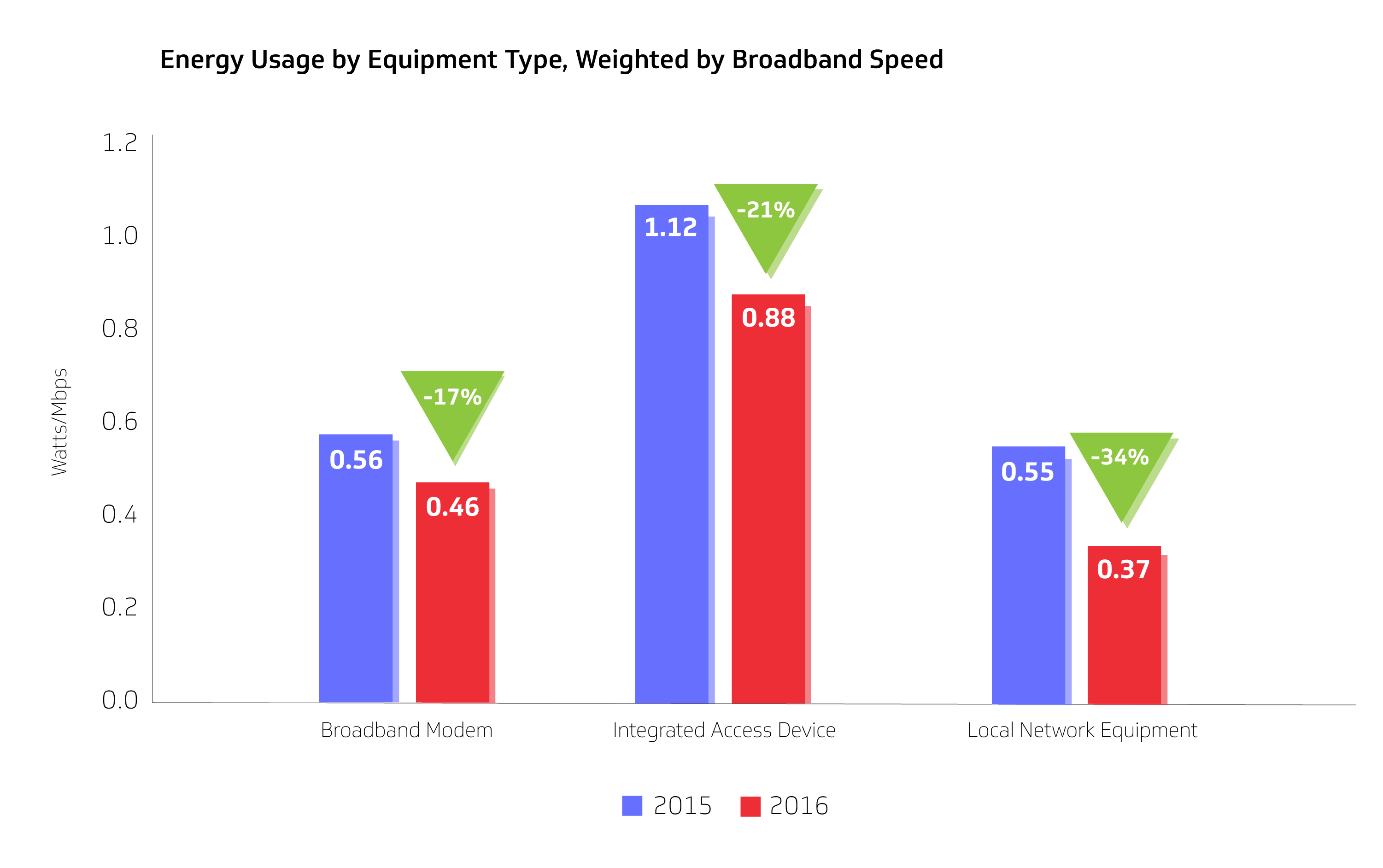 Figure 3: SNE VA Energy Trends
Figure 3: SNE VA Energy TrendsCanadian Set-Top Box Voluntary Agreement
Following the efficiency gains achieved in the United States, the Canadian Pay TV industry also recently adopted its own STB VA, also working with energy advocates and relevant governmental agencies. The Canadian Energy Efficiency Voluntary Agreement for Set-Top Boxes (CEEVA) includes the five largest television content distributors, covering nearly 90 percent of subscribers in Canada. Modeled after the US STB VA, the Canadian service providers signed up to a very similar set of commitments:
- Beginning in 2017, at least 90 percent of all new set-top boxes purchased must meet ENERGY STAR Version 3.0 levels (referred to as Tier 1 in the agreement).
- Beginning in 2018, at least 90 percent of all new set-top boxes purchased must meet more stringent Tier 2 levels as defined in the agreement (the same Tier 2 as defined in the US STB VA). The CEEVA Tier 2 commitments run through 2021, with an annual report issued in 2022.
- Signatories are required to have their STB models tested by an accredited third-party test lab and submit an annual report to an independent third party that will prepare a public annual report.
- All service providers must make energy information for new STB models publicly available to consumers.
- Like the US VA, CEEVA also allows for innovation in the marketplace through a New Feature Process.
This agreement was the result of collaboration among competitors in the Pay TV space encompassing the cable, satellite, and telco markets, as well as manufacturers, regulators, and utilities. The signatories to date are:
- Bell
- Cogeco Communications
- Rogers Communications
- Shaw Communications
- Vidéotron Ltd.
- Arris
- Echostar Technologies
- Technicolor
Regulators and utilities were also involved in the discussions and negotiations when standing up CEEVA. The effort was initially driven by Natural Resources Canada (NRCan), and also included the Ontario Ministry of Energy, the BC Ministry of Energy and Mines, Quebec’s Ministère de l’Énergie et des Ressources naturelles, and Manitoba’s Department of Growth, Enterprise and Trade. Provincial utilities included BC Hydro, Independent Electricity System Operator, Manitoba Hydro, SaskPower, and Hydro Québec.[12]
“Collaborative agreements such as this can lower Canada’s annual carbon emissions and help meet its climate change goals – and that is something our Government is proud to highlight.”
-- Jim Carr, Canada’s Minister of Natural Resources[13]
The first CEEVA reporting period just completed in 2017 and the first annual report is expected to be released around mid-2018.
Efficiency at the Speed of Innovation
A key feature of the three energy efficiency voluntary agreements discussed in this paper is the new feature allowance process. This process allows service providers, manufacturers, and vendors to flexibly address energy consumption while continuing to innovate on their platforms. If a new feature would cause a device to exceed the existing total energy consumption allowance, then the signatory can still deploy the product while proposing an additional allowance for the new feature. A signatory may deploy a new feature without advance notice or permission to ensure that companies are able to access first-mover and competitive advantages from the new technology, from which consumers benefit through access to these innovations. The parties then study the new feature to establish an appropriate allowance for the new feature going forward. This process ensures that new features are promptly and transparently brought within the energy efficiency commitments to the agreement once they have been adopted.[14] The new feature allowance process was used in the STB VA by introducing new allowances for Ultra High Definition–4K, High Efficiency Video Processing, and Telephony in 2016.
Relative to a more static and prescriptive regulatory alternative, the STB and SNE VAs have delivered much faster adoption and deployment of energy efficient devices. The STB VA is reported to save a total of 16.8 TWh of energy over its first four years since 2013. By contrast, under federal law, mandatory Department of Energy efficiency standards could not have even become effective for five years.[15] Furthermore, industry leadership enables energy savings to existing devices through software updates, whereas a regulatory approach would apply only to new devices.
Voluntary agreements also offer accountability and rapid, effective remediation. Under the terms of the STB VA, if a signatory falls short of their commitments, they are required to propose a remedial plan for approval by a review panel (including energy advocates), which will secure even more energy savings than the initial commitment. This enforcement structure has been put to the test with success. In each of the first two years of the STB VA, a different company fell short on their 90 percent procurement commitment. These parties then proposed and implemented a remedial energy savings plan, as the agreement requires. The flexibility of this process enables creative and rapid remediation; in both cases, the parties were already implementing energy saving remediation measures by the beginning of the next year - much faster than would have been likely to occur under more formal and adversarial regulatory enforcement proceedings conducted under administrative law procedures.
"Reducing federal regulatory burdens is a priority for myself and this Administration, and voluntary industry standards such as this are an effective alternative to government regulation." – Rick Perry, Secretary of Energy[17]
Because of the speed at which change can be effected, the flexibility to evolve standards, and the ability to deliver accountability, U.S. policy has long favored industry leadership in meeting public goals. White House Office of Management and Budget Circular A-119 articulates US policy preferences to rely on industry standards over Government-prescribed requirements.[16] Circular A-119 provides guidance to federal agencies to limit the cost to the Federal Government from developing its own standards, provide incentives to establish standards which serve national needs, and encourages further reliance upon private sector expertise to supply the Federal Government with cost-efficient goods and services. The STB and SNE VAs are consistent with this policy by focusing on a voluntary consensus program and using industry expertise to effectively address energy efficiency objectives.
Industry leadership also improves certainty in the market by insulating the programs from shifts in political or policy priorities. Improved certainty facilitates continued innovation around energy efficiency and may result in larger energy savings through program continuity. As these industry-led initiatives proceed, is important that the public sector is informed of processes, goals, and outcomes. This dialogue can help to ensure that private efforts are appropriately targeted toward public outcomes. An industry-led, consensus approach is the only framework that can achieve these energy savings at such a rapid pace, while enabling new product innovations.
Energy Savings Into The Future
When the then-current terms of the US STB VA and the SNE VA expired at the end of 2017, the steering committees for each agreement adopted resolutions that the parties would continue to follow the commitments of the agreements as they finalized terms to extend the agreements. The STB VA was then extended for four additional years through 2021, with new terms that include an even more rigorous set of Tier 3 energy levels that will take effect in 2020.[18] It has a similar structure and terms with additional reporting regarding service provider applications that run on consumer devices such as smart TVs, mobile phones, tablets, and PCs.
The extended STB VA is expected to save $1.6 billion and avoid CO2 emissions equivalent to 2 million passenger cars each year.
The extended STB VA, with its new commitments and stricter energy tiers, is expected to save an additional $600 million per year, for a total of $1.6 billion in annual savings. In emissions terms, this equates to avoiding 9.3 million metric tons CO2, which is the equivalent of eliminating the emissions of more than 2 million passenger cars each year.
With the STB VA renewal completed, efforts to extend the US SNE VA are actively underway.
Conclusion
Cable industry energy efficiency efforts have realized significant environmental and monetary benefits while enabling innovation at the pace required in a technology sector. Initial successes have been validated through renewal of the agreements and their extension into Canada, in consultation with energy advocates and government stakeholders. Reducing the energy consumption of STBs and SNE through collaborative, industry-led energy efficiency voluntary agreements generates key consumer benefits including lower energy bills, innovative new product features, and a cleaner environment. Cable operators and technology vendors remain committed to the continued success of these agreements.
Endnotes
- [1] 2017 State of Telecommuting in the U.S. Employee Workforce, Global Workplace Analytics & Flexjobs 3, 23 (2017), available at http://globalworkplaceanalytics.com/telecommuting-statistic
- [2] http://www.scte.org/SCTE/Areas_of_Interest/Energy_2020__Powering_Cable_s_Success.aspx
- [3] In 2016, the STB VA was awarded the Top Project of the Year Award by Environmental Leader: https://www.environmentalleader.com/products/consumer-technology-association-and-national-cable-telecommunications-association-voluntary-agreement-for-ongoing-improvement-to-the-energy-efficiency-of-set-top-boxes/
- [4] http://www.energy-efficiency.us/
- [5] http://www.energyefficiency-va.ca/
- [6] Annual reports for the STB VA are located at http://www.energy-efficiency.us/
- [7] Links to each service provider public posting of their STB energy consumption are available at http://www.energy-efficiency.us/
- [8] Note that Tier 2 was defined by the STB VA signatories because, at the time, the current ENERGY STAR STB program was still at version 3.0, and ENERGY STAR had not yet finalized the next version of the program. When ENERGY STAR released their STB version 4.1 program, it adopted many aspects of the STB VA program including the test procedure.
- [9] https://energy.gov/articles/us-energy-department-pay-television-industry-and-energy-efficiency-groups-announce-set-top
- [10] https://www.energy.gov/articles/us-energy-department-pay-television-industry-and-energy-efficiency-groups-announce-set-top
- [11] Savings is measured from a 2012 baseline. See http://www.energy-efficiency.us/library/pdf/STB2016AnnualReport.pdf for the full report.
- [12] https://www.cablelabs.com/news/pay-tv-service-providers-and-manufacturers-announce-set-top-box-energy-efficiency-agreement/
- [13] https://www.cablelabs.com/news/pay-tv-service-providers-and-manufacturers-announce-set-top-box-energy-efficiency-agreement/
- [14] STB VA annual report page 13 http://www.energy-efficiency.us/library/pdf/STB2016AnnualReport.pdf
- [15] 42 U.S.C. § 6295(l)(2) (“Any new or amended standard for covered products of a type specified in paragraph (19) of section 6292(a) of this title shall not apply to products manufactured within five years after the publication of a final rule establishing such standard.”)
- [16] Office of Management and Budget, OMB Circular A-119: Federal Participation in the Development and Use of Voluntary Consensus Standards and in Conformity Assessment activities, https://www.gpo.gov/fdsys/pkg/CFR-2010-title47-vol1/pdf/CFR-2010-title47-vol1-sec12-2.pdf
- [17] https://www.energy-efficiency.us/library/pdf/EnergyEfficiencyRelease2018.pdf
- [18] https://www.cablelabs.com/set-top-box-energy-efficiency-voluntary-agreement/
About Cablelabs
As the leading innovation and R&D lab for the cable industry, CableLabs creates global impact through its member companies around the world and its subsidiaries, Kyrio and UpRamp. With a state-of-the art research and innovation facility and collaborative ecosystem with thousands of vendors, CableLabs delivers impactful network technologies for the entire industry.
About Informed Insights
CableLabs created the Inform[ED] Insights series to periodically address major technology developments that have the potential to transform the cable business and society at large.
The cable industry connects and entertains people across the globe, contributing significantly to economic growth and enabling rich discourse in our countries of operation. Inform[ED] Insights will provide leaders across sectors and disciplines with communications technology facts and insights on which to base decisions of significance.


